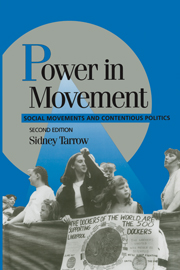Book contents
- Frontmatter
- Contents
- List of Figures
- Preface
- Acknowledgments
- Introduction
- 1 Contentious Politics and Social Movements
- PART 1 THE BIRTH OF THE MODERN SOCIAL MOVEMENT
- PART II FROM CONTENTION TO SOCIAL MOVEMENTS
- PART III THE DYNAMICS OF MOVEMENT
- Conclusion: The Future of Social Movements
- Notes
- Sources
- Index
- CAMBRIDGE STUDIES IN COMPARATIVE POLITICS
1 - Contentious Politics and Social Movements
Published online by Cambridge University Press: 05 June 2012
- Frontmatter
- Contents
- List of Figures
- Preface
- Acknowledgments
- Introduction
- 1 Contentious Politics and Social Movements
- PART 1 THE BIRTH OF THE MODERN SOCIAL MOVEMENT
- PART II FROM CONTENTION TO SOCIAL MOVEMENTS
- PART III THE DYNAMICS OF MOVEMENT
- Conclusion: The Future of Social Movements
- Notes
- Sources
- Index
- CAMBRIDGE STUDIES IN COMPARATIVE POLITICS
Summary
Contentious politics emerges in response to changes in political opportunities and constraints, with participants responding to a variety of incentives: material and ideological, partisan and group-based, long-standing and episodic. Building on these opportunities, and using known repenoires of action, people with limited resources can act contentiously – if only sporadically. When their actions are based on dense social networks and connective structures and draw on consensual and action-oriented cuirural frames, they can sustain these actions in conflict with powerful opponents. In such cases – and only in such cases – we are in the presence of a social movement; when contention spreads across an entire society, as it sometimes does, we see a cycle of contention; when such a cycle is organized around opposed or multiple sovereignties, the outcome is a revolution. The solutions to the collective action problem depend on shared understandings, on dense social networks and connective structures, and on the use of culturally resonant forms of action. But above all, I believe, they are triggered by the ebb and flow of political struggle.
In this chapter, I lay out each of these factors as they will be used to describe, analyze, and raise questions about contentious politics and social movements in the rest of this book. Before doing so, however, it will be helpful to see how previous generations of activists and scholars conceived of the problem of collective action and its relation to grievances, resources, cultural frames, and politics.
- Type
- Chapter
- Information
- Power in MovementSocial Movements and Contentious Politics, pp. 10 - 26Publisher: Cambridge University PressPrint publication year: 1998
- 2
- Cited by

